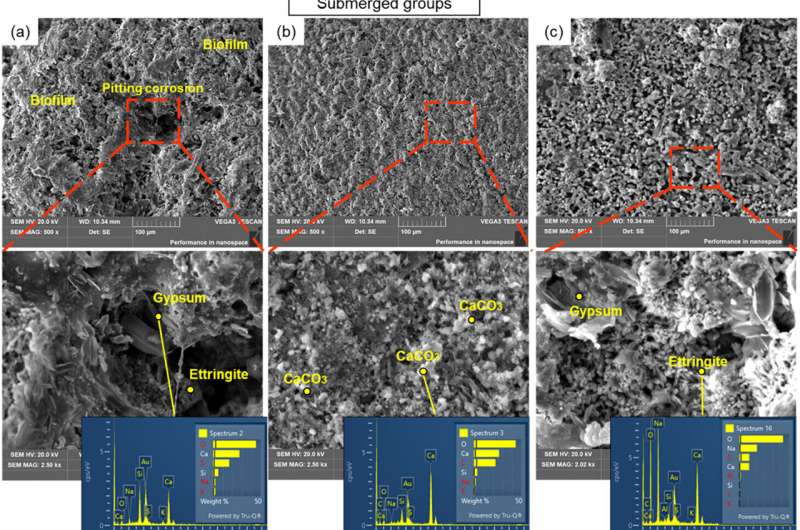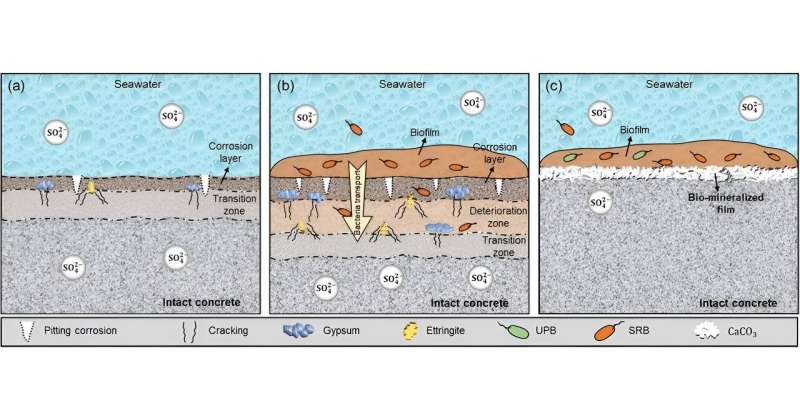
Microbially induced corrosion (MIC) is a prevalent issue in marine environments, leading to structural damages such as cracking in concrete infrastructure. This corrosion poses a persistent challenge, significantly reducing the lifespan of marine structures and resulting in substantial economic losses.
In response to the need for an effective solution to combat the marine corrosion on concrete, researchers at the Hong Kong Polytechnic University have developed a biomineralization approach to protect marine concrete from MIC.
Prof. Xiang-dong Li, Dean of the Faculty of Construction and Environment, Director of the Research Institute for Sustainable Urban Development, Chair Professor of Environmental Science and Technology, and Ko Jan Ming, Professor in Sustainable Urban Development, has led the research that successfully introduced a novel biomineralization strategy, which effectively isolates marine concrete from MIC, thereby contributing to the achievement of sustainable coastal structures.
MIC on concrete usually occurs in harsh environments with the presence of corrosive microorganisms, such as sewage structures, wastewater treatment plants, and marine structures. The formation of a biomineralized film on concrete surfaces is typically considered to be the major anticorrosion mechanism, as it can provide a barrier to inhibit corrosion.

Prof. Li said, "The biomineralization technique serves as an environmentally friendly coating method for controlling concrete corrosion, with minimal impact on the overall biofilm communities. Also, it utilizes carbon dioxide to produce mineral precipitates, enhancing the durability of concrete structures."
"This process not only reduces the carbon footprint and energy consumption of marine infrastructure throughout its lifespan but also makes a valuable contribution to carbon neutrality and sustainability."
The study showed the biomineralization treatment effectively prevents corrosion by reducing the total and relative abundance of sulfate-reducing bacteria (SRB). SRB is a type of anaerobic bacteria and can produce hydrogen sulfide, which is corrosive and can lead to material deterioration.
The biomineralized film acts as a protective layer, controlling sulfate diffusion and isolating the concrete from the corrosive SRB communities. This protective mechanism significantly extends the lifespan of concrete structures. Moreover, this technique has no negative impact on the native marine microbial communities.
Prof. Li added, "If the biomineralized film remains intact, repainting the concrete structures is unnecessary. The utilization of a single coating treatment eliminates the need for multiple treatments, further minimizing the cost and carbon footprint."
This biomineralization strategy has strong potential for applications in corrosive environments, such as marine environments, sewage environments, and water cooling utilities, where concrete corrosion is induced by corrosive microorganisms.
More information: Xiaohao Sun et al, Biomineralization To Prevent Microbially Induced Corrosion on Concrete for Sustainable Marine Infrastructure, Environmental Science & Technology (2023). DOI: 10.1021/acs.est.3c04680
Citation: Researchers introduce biomineralization as a sustainable strategy against microbial corrosion in marine concrete (2024, February 23) retrieved 23 February 2024 from https://techxplore.com/news/2024-02-biomineralization-sustainable-strategy-microbial-corrosion.html
This document is subject to copyright. Apart from any fair dealing for the purpose of private study or research, no part may be reproduced without the written permission. The content is provided for information purposes only.
